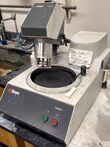Ductile Iron - Polishing
Jump to navigation
Jump to search
This SOP describes the process of polishing SSFDI to prevent contamination, graphite pull-out, and other polishing defects. This SOP references SME Julia Scruton and Ale Almanza polishing steps for Ductile Iron.
Polishing Steps for Solid Solution Strengthen Ferritic Ductile Iron
| Grit | Force | Time | Head Rotation |
|---|---|---|---|
| 120 | 15N | until flat | yes |
| 180 | 15N | 1 minute | yes |
| 600 | 15N | 1 minute | yes |
| 800 | 15N | 1 minute | no |
| 1200 | 15N | 1 minute | no |
| 1μ diamond | 15N | 1 minute | no |
| 0.05 Al2O3 | 15N | 1 minute | no |
Safety Concerns
- Make sure fingers and debris are clear from rotating head and base
- If etching samples, be in a fume hood and wear gloves
- Have safety glasses on at all times
- Report any problems to Dr. Dan Seguin
SSFDI Polishing Procedure
- Gather necessary consumables:
120 Grit Paper
180 Grit Paper
320 Grit Paper
600 Grit Paper
800 Grit Paper
1200 Grit Paper
Felt Pad
Red Lub3
0.5 Al2O3 Suspension - Adhere grit paper to the magnetic pad and place on the Struthers Polisher
- Place Samples into the Struthers Polisher
- Turn On Polisher
- Set timer and add necessary parameters
- Reference Table For Specific Settings Per Polishing
- Add two drops off Red Lube, add more when the polisher head makes a clanking sound
- To make the autopolisher head static, turn off the switch located on the back of the base of the polisher - After each polish, clean the samples with water and dry with the air compressor
- Remove grit paper and dispose
- Do NOT dispose of cloth pad for final polishing steps - Repeat 1-6 until polishing steps are compeleted
Etching
For further analysis of microstructure, a 3% nital etchant can be used
- Gather necessary consumables:
3% nital etchant
petri dish
cotton swab or pad - In a fume hood, turn on the water
- Pour nital into petri dish
- Dip cotton swab/pad into the etchant
- Once the sample surface start to become cloudy, rinse the sample with running water
- Dry sample with air compressor



